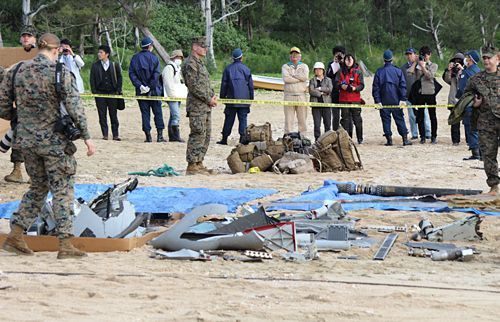US military sets up restricted area on beach to keep people away from Osprey wreckage

U.S. soldiers section off the beach with restriction tape and clean up the wreckage of the airframe on December 15 in Abu, Nago City.
December 16, 2016 Ryukyu Shimpo
On December 15, the wreckage of the MV-22 Osprey vertical takeoff and landing aircraft from Futenma Air Station that crashed on the shore in Abu, Nago, was moved to a separate beach about 800 meters away from the actual crash site. In order to ensure passage for carrying out the wreckage between the beach and a waiting lot for military trucks, the U.S. military singlehandedly put up restriction tape around an expansive area of the beach. After this, upon Nago City Council members coming to observe and protest, the soldiers reduced the restricted area by 30 square meters. By taking initiative and moving the wreckage from the actual crash site and setting up restriction tape singlehandedly, the U.S. military did not observe the rules set forth in guidelines concerning U.S. aircraft accidents.
The Guidelines Regarding Off-Base U.S. Military Aircraft Accidents in Japan have established procedures for restricting access to a crash site. These set forth that the “inner cordon” in close vicinity to the crash site will be jointly manned (by the U.S. military and Japan’s law enforcement authorities) “except in extraordinary circumstances.” They do not stipulate that the U.S. military will singlehandedly control access restriction to the site. The U.S. military is only able to regulate “spectators” until the arrival of the Japanese police or coast guard.
Generally under these guidelines, the Japanese authorities will establish an “outer cordon” around the inner cordon. However, on the beach there was only one line of restriction tape, which about 20 prefectural riot police officers guarded after the U.S. military had put it up.
In regards to the U.S. military using restriction tape, the Nago police said they understood the U.S. military’s temporary measures to put the wreckage on the shore, but they could not confirm precisely why the U.S. military went so far as to put up its own restriction tape.
(English translation by T&CT and Erin Jones)
Previous Article:Onaga calls for removal of “defective” Osprey; government refuses to cancel land return ceremony
Next Article:Electronic extra edition: MV-22 Ospreys belonging to Futenma base resume full flight despite objections from Okinawa
[Similar Articles]
- U.S. military helicopter crashes in training area near village
- U.S. military not allowing Okinawa government to enter site of Takae helicopter fire to conduct radiation test
- U.S. helicopter makes emergency landing on Tsuken Jima, local residents concerned about danger to homes
- Electronic extra edition: MV-22 Ospreys belonging to Futenma base resume full flight despite objections from Okinawa
- Soil contaminated with harmful substance at U.S. helicopter crash site
 Webcam(Kokusai Street)
Webcam(Kokusai Street)


